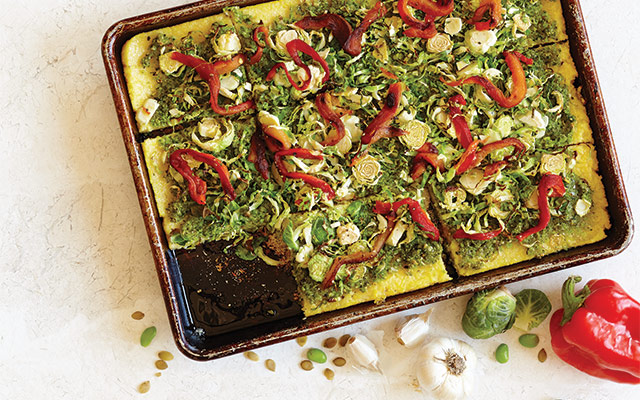Sweet Spot
 Peak season for Brussels sprouts comes right after the first hard frost. The cold weather compels the plants to convert some of their stored starches into sugars to keep the sprouts from freezing, resulting in a tender, more mellow-tasting veggie. Smaller Brussels sprouts also tend to have a sweeter flavor, while larger ones will taste slightly bitter and more sulfuric — much like their cabbage cousins.
Peak season for Brussels sprouts comes right after the first hard frost. The cold weather compels the plants to convert some of their stored starches into sugars to keep the sprouts from freezing, resulting in a tender, more mellow-tasting veggie. Smaller Brussels sprouts also tend to have a sweeter flavor, while larger ones will taste slightly bitter and more sulfuric — much like their cabbage cousins.
Shop and Store
 Choose bright, whole, firm sprouts with minimal yellow or brown spots. If you can find sprouts on the stalk, snap them up. They’ll stay fresher longer because the stalk helps the veggie retain moisture and nutrients. Store loose sprouts in a bag in your crisper drawer for up to a week and wash just before cooking to keep the outer leaves from wilting. If you bought a whole stalk of sprouts, wrap the bottom end in a damp towel to extend its shelf life.
Choose bright, whole, firm sprouts with minimal yellow or brown spots. If you can find sprouts on the stalk, snap them up. They’ll stay fresher longer because the stalk helps the veggie retain moisture and nutrients. Store loose sprouts in a bag in your crisper drawer for up to a week and wash just before cooking to keep the outer leaves from wilting. If you bought a whole stalk of sprouts, wrap the bottom end in a damp towel to extend its shelf life.
Second Chance
 If Brussels sprouts still call to mind the odorous, overcooked mini-cabbages of your youth, it might be time to reconsider them. Sprouts benefit from high-heat cooking methods like roasting or searing, which brown the veggie’s natural sugars and balance its earthy taste. Be sure to cook until tender — not mushy — and season with salt and black pepper. Add a savory ingredient like tamari or an acid like lemon juice to round out the flavor.
If Brussels sprouts still call to mind the odorous, overcooked mini-cabbages of your youth, it might be time to reconsider them. Sprouts benefit from high-heat cooking methods like roasting or searing, which brown the veggie’s natural sugars and balance its earthy taste. Be sure to cook until tender — not mushy — and season with salt and black pepper. Add a savory ingredient like tamari or an acid like lemon juice to round out the flavor.
Versatile Veg
 That slightly sulfuric flavor pairs well with bacon, as in our Bacon-Braised Brussels Sprouts. For a vegetarian spin, try our Sautéed Brussels Sprouts With Coconut. Don’t want to cook your sprouts at all? Try them raw in our Brussels Sprouts Salad, or take the fermentation route with our Brussels Sprouts Kimchi.
That slightly sulfuric flavor pairs well with bacon, as in our Bacon-Braised Brussels Sprouts. For a vegetarian spin, try our Sautéed Brussels Sprouts With Coconut. Don’t want to cook your sprouts at all? Try them raw in our Brussels Sprouts Salad, or take the fermentation route with our Brussels Sprouts Kimchi.
This article originally appeared as “Brussels Sprouts” in the November 2021 issue of Experience Life.





This Post Has 2 Comments
The thought of ‘searing’ , browning, high heat and roasting Brussel sprouts is awful. As a Brit I usually had them steamed and tossed in butter, a little cider or balsamic vinegar and eaten with roast parsnips, chicken or Turkey and lots of gravy. Now we have them just steamed the same way with carrots as an addition to salad . Blasting things with extreme heat or frying these wonderful vegetables seems a bit pointless to me. I try to avoid all fried food if possible
Thank You for the recipe,I never knew how to cook Brussel sprouts, this sounds good and easy.
Thank You